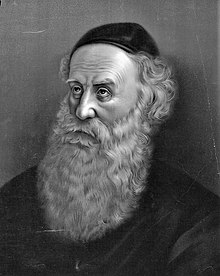Schneur Salman

Rabbi Schne'ur Salman von Liadi ( Hebrew שניאור זלמן מליאדי) (Born 4 . Jul / 15 September 1745 greg. In Liozna ; died on 15 jul. / 27. December 1812 greg. In Hadicz ) was the founder of the Hasidic Chabad -Lubawitsch movement.
His teacher, Dow Bear von Mesritsch , was one of the students of Israel ben Eliezer (also known as the Baal Shem Tov ), the founder of Hasidism . Schneur Salman's son, Dovber Schneuri, moved the headquarters of the movement founded by his father to Lubavitch in what is now Russia . The Chabad-Lubavitch movement stayed here until 1915.
Schneur Salman published a systematic summary of Hasidic philosophy known as Tanya in 1797. He also wrote Shulchan Aruch haRav , his version of the classic Shulchan Aruch , in which halachic decisions and their justifications are detailed .
The name Schneor means “two lights” in Hebrew . In retrospect, his name was related to his two main works - Shulchan Aruch HaRav in the field of Halacha and The Book of Tanja in the field of Kabbalah . His father Baruch was a descendant of the Prague rabbi and philosopher Judah Löw .
In 1760 Schneor married Salman Sterna, the daughter of the magnate Yehuda Lejb Segal from Vitebsk . In 1764 he traveled for the first time to study with Rabbi Dow Bär von Mesritsch. In 1767 he took over the post of Maggid in the municipality of Ljosna ( Russian : Лёзна, Belarusian : Лиозно). In 1770 he began work on his halachic work Shulchan Aruch on the instructions of Dow Bear . To better distinguish the Schulchan Aruch of the same name from Rabbi Josef Karo , the work by R. Schneor Salman is called "Schulchan Aruch HaRav ". In 1772 he began formulating the basic tenets of the Chabad philosophy; 1773–1778 he established a yeshiva for selected scholars in the city of Ljosna, where he lived and taught. In 1794 he published (anonymously for the time being) his first halachic work Hilchot Talmud Tora ("The Laws of Torah Study"), which was later printed as part of the Shulchan Aruch HaRav . In 1797 he published his main work on the philosophy of religion, the book Tanja . In 1803 he published a siddur (prayer book) following the rite of Isaac Luria . In 1812 he fled with his family and some students from the approaching troops of Napoleon and died on 24 Tevet 5573 (December 27, 1812) in the village of Hadicz in the Poltova district, where his grave is also located. He left a large community of students, followers, scholars and rabbis who carried on his ideas and movement. The Chabad Lubavitch developed some innovative ideas deviating from the Hasidism of Baal Shem Tov , which were also reflected in their songs.
Since 1972 there has been an annual meeting of the descendants of Rabbi Schneur Salman (כינוס הצאצאים).
In 1980 the book Sefer Ha-Zezaim (ספר הצאצאים) was published, which contains biographical information on several hundred descendants of R. Schneur Salman. In 2007, biographical information on almost 6000 descendants was collected for a new edition of the book.
literature
- Schneor Salman von Ljadi: The book Tanja. In Dt. translated by Levi Sternglanz, Vienna 2000, ISBN 0-8266-6124-6 .
Web links
swell
- ^ The book Tanja, translated into German by Levi Sternglanz under the direction of Rabbi Jacob I. Biderman, Kehot Publication Society, Vienna 2000, 486 pages, ISBN 0-8266-6124-6
- ^ Rabbi Schneor Salman von Ljadi, Shulchan Aruch, Revised Edition, 6 vol. + Mafteach Inyanim, New York 2006, ISBN 0-8266-5199-2 (set)
- ^ Biographical data according to Das Buch Tanja (German translation), Vienna 2000, p. 460; ISBN 0-8266-6124-6 ; and according to HaYom Yom , Bilingual edition Hebrew-English, New York 1994, ISBN 0-8266-0670-9 , pp. A8-A9
- ↑ Sholom Kalib: The Musical Tradition of the Eastern European Synagogue , Volume I ( Introduction: History and Definition ), Part I ( Text ), Syracuse University Press, New York, 2002, p. 80
- ^ Kfar Chabad Magazine, December 28, 2007; here online , accessed December 31, 2007
| personal data | |
|---|---|
| SURNAME | Salman, Schneur |
| ALTERNATIVE NAMES | Salman, Schne'ur; שניאור זלמן מליאדי (Hebrew) |
| BRIEF DESCRIPTION | Founder of the Hasidic Chabad Lubavitch movement |
| DATE OF BIRTH | September 15, 1745 |
| PLACE OF BIRTH | Lyosna |
| DATE OF DEATH | December 27, 1812 |
| Place of death | Hajach |
